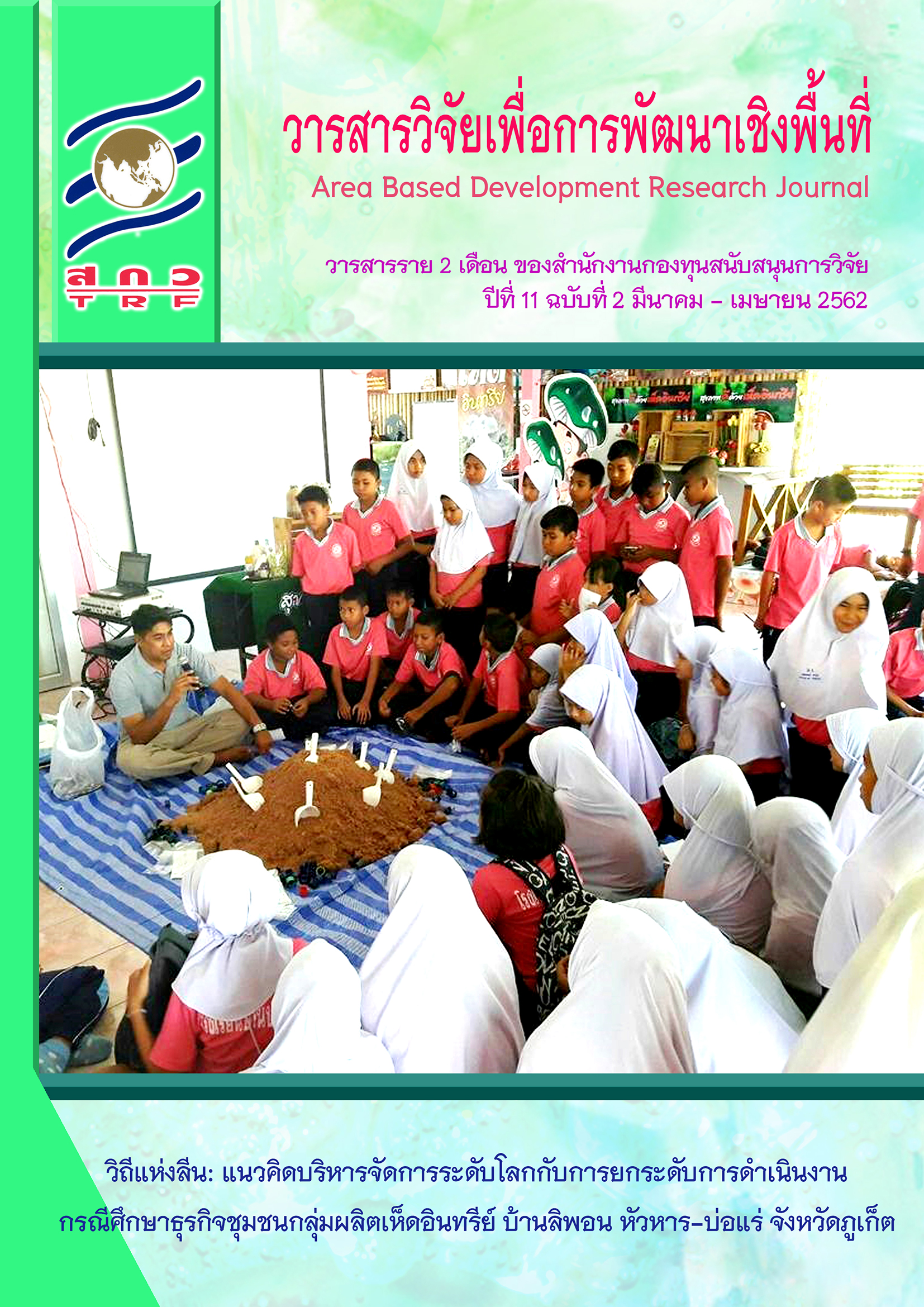Development of Community Boar Semen Production Center for Artificial Insemination to be Used by Smallholder Farmers in Tambon Muang Jang, Nan Province
Main Article Content
Abstract
The majority of the pig farmers in the Tambon Muang Jang, in Nan Province are smallholder farmers and some of them have formed a pig production group. Farmers have been trained and are able to detect heat and perform artificial insemination (AI) in their sows. However, boars are not reared on the farm and therefore boar semen is not produced to do on-farm AI. When sows are observed to be in standing estrus, farmers use a cool box to fetch the boar semen from the Center of Learning Network for the Region (CLNR), Chulalongkorn University. Sometimes boar semen provision is lower than the demand and sometimes the sow shows signs of standing estrus at the weekend when the semen collection service is unavailable. Both problems lead to economic losses for the farmers because insemination cannot be performed. This study aims to create a community boar semen production center and produce high genetic boar semen to be used for artificial insemination in sows in the community. Farmer participation is recorded in all processes and activities within this study. The project starts by gathering farmer data and information in order to understand farmers and their needs. Boar semen collection and a preparation training course are organized to train a selected number of farmers. Boar housing and an artificial insemination laboratory is established. A steering committee is formed to manage the community boar semen production center. The project succeeds in training four farmers who have passed the training course. They have obtained the skills necessary to produce chilled boar semen for artificial insemination. Two high genetic boars are introduced into the community boar semen production center for semen collection. When operating, the center provides 135 individual farmers with 2 doses of chilled semen per time to inseminate their sows during September 2014 – October 2016. The results of the project have an impact on the socio-economics of the farmers by avoiding economic losses from insufficient semen production. The community boar semen production center is located in the community which means that farmers do not waste time going to the CLNR. This center can be a self-reliant model for community boar semen production that is applicable to other communities.
Article Details

This work is licensed under a Creative Commons Attribution-NonCommercial-NoDerivatives 4.0 International License.
Area Based Development Research Journal values copyright protection and licensing to safeguard author rights and facilitate the appropriate dissemination of research. Our policies ensure openness, accessibility, and attribution. Authors retain copyright ownership, and articles are published under a Creative Commons Attribution License (CC BY), allowing sharing, adaptation, and proper attribution. Authors have the freedom to publish under the CC BY license, granting broad reuse and distribution permissions. The journal supports posting articles on third-party repositories, adhering to institutional and funding restrictions. Author guidelines detail copyright and licensing requirements, empowering authors with knowledge about their rights and responsibilities. These policies cultivate an environment of collaboration, openness, and responsible sharing, benefiting authors and the research community while honoring intellectual property rights.
References
วิชัย ทันตศุภารักษ์, มงคล เตชะกําพุ, จันทร์เพ็ญ สุวิมลธีระบุตร, วีร์ธิมาวิศาลเวทย์, ฉลองศรี พลโยธา, ขจร นิติวรารักษ์, ... ปวีณา ดิลกสัมพันธ์. (2552). โครงการการขยายเครือข่ายเกษตรกรรายย่อยและการเลี้ยงสุกรด้วยวิธีเกษตรธรรมชาติในจังหวัดน่าน. (รายงานวิจัยฉบับสมบูรณ์). กรุงเทพฯ: จุฬาลงกรณ์มหาวิทยาลัย.
วิชัย ทันตศุภารักษ์, มงคล เตชะกําพุ, จันทร์เพ็ญ สุวิมลธีระบุตร, วีร์ธิมาวิศาลเวทย์, ฉลองศรี พลโยธา, ขจร นิติวรารักษ์, ... ปวีณา ดิลกสัมพันธ์. (2553). โครงการการขยายเครือข่ายเกษตรกรรายย่อยและการเลี้ยงสุกรด้วยวิธีปศุสัตว์อินทรีย์ในจังหวัดน่าน. (รายงานวิจัยฉบับสมบูรณ์). กรุงเทพฯ : จุฬาลงกรณ์มหาวิทยาลัย.
วิชัย ทันตศุภารักษ์, มงคล เตชะกําพุ, จันทร์เพ็ญ สุวิมลธีระบุตร, วีร์ธิมาวิศาลเวทย์, ณ พัทธ์ ปัณฑุกำพล, ฉลองศรี พลโยธา, ... ขจร นิติวรารักษ์. (2554). โครงการการขยายเครือข่ายเกษตรกรรายย่อยและการเลี้ยงสุกรด้วยวิธีปศุสัตว์อินทรีย์ในจังหวัดน่าน. (รายงานวิจัยฉบับสมบูรณ์). กรุงเทพฯ: จุฬาลงกรณ์มหาวิทยาลัย.
วิชัย ทันตศุภารักษ์, มงคล เตชะกําพุ, จันทร์เพ็ญ สุวิมลธีระบุตร, วีร์ธิมา วิศาลเวทย์, ณ พัทธ์ ปัณฑุกำพล, ฉลองศรี พลโยธา, ... ขจร นิติวรารักษ์. (2555). โครงการการพัฒนาแม่แบบเพื่อการส่งเสริมการผลิตสุกรอินทรีย์ การบริการด้านผสมเทียม และการสร้างฝูงผลิตแม่พันธุ์ทดแทนให้กับการเลี้ยงสุกรในระบบปศุสัตว์อินทรีย์ที่ศูนย์นวัตกรรมเพื่อการบริการวิชาการแก่ชุมชนน่าน. (รายงานวิจัยฉบับสมบูรณ์). กรุงเทพฯ: จุฬาลงกรณ์มหาวิทยาลัย.
วินัย แก้วละมุล, ขจร นิติวรารักษ์, ศราวณี ขันมณี และ วิชัย ทันตศุภารักษ์. (2561). การพัฒนาช่องทางจัดจำหน่ายเนื้อสุกรของกลุ่มเกษตรกรบ้านทุ่งขาม จังหวัดน่าน. วารสารวิจัยเพื่อการพัฒนาเชิงพื้นที่, 10(6), 453–470.
สิทธิเดช พงศ์กิจวรสิน และ เขมรัฐ เถลิงศรี. (2558). ข้าวโพดเลี้ยงสัตว์กับการสูญเสียพื้นที่ป่า: ปัญญาและทางออก. เอกสารเผยแพร่สำนักประสานงานชุดโครงการงานวิจัยเชิงนโยบายเกษตรและเสริมสร้างเครือข่ายงานวิจัยเชิงนโยบาย สถาบันคลังสมองของชาติร่วมกับสำนักงานกองทุนสนับสนุนการวิจัย. กรุงเทพฯ: บริษัท ซีโน พับลิชชิ่ง แอนด์ แพคเกจจิ้ง จำกัด.
อรรณพ คุณาวงษ์กฤต. (2543). การศึกษาและวิจัยเพื่อการผสมเทียมสุกร. เวชชสารสัตวแพทย์, 30(1), 13–17.
Am-In, N., Tantasuparuk, W., & Techakumphu, M. (2010). Comparison of artificial insemination with natural mating on smallholder farms in Thailand, and the effects of boar stimulation and distance of semen delivery on sow reproductive performance. Tropical Animal Health and Production, 42(5), 921–924.
Buranaamnuay, K., Tummaruk, P., & Techakumphu, M. (2010). Intra-uterine insemination with low numbers of frozen–thawed boar spermatozoa in spontaneous and induced ovulating sows under field conditions. Livestock Science, 131, 115–118.
Kedkovid, R., Woonwong, Y., Arunorat, J., Sirisereewan, C., Sangpratum, N., Lumyai M., ... Thanawongnuwech, R. (2018). Porcine circovirus type 3 (PCV3) infection in grower pigs from a Thai farm suffering from porcine respiratory disease complex (PRDC). Veterinary Microbiology, 215, 71–76.
Knox, R. V. (2016). Artificial insemination in pigs today. Theriogenology, 85, 83–93.
Knox, R., Levis, D., Safranski, T., & Singleton, W. (2008). An update on North American boar stud practices. Theriogenology, 70, 1202–1208.
Nuntapaitoon, M., Muns, R., Theil, P. K., & Tummaruk, P. (2018). L-arginine supplementation in sow diet during late gestation decrease stillborn piglet, increase piglet birth weight and increase immunoglobulin G concentration in colostrum. Theriogenology, 121, 27–34.
Roca, J., Parrilla, I., Bolarin, A., Martinez, E. A., & Rodriguez-Martinez, H. (2016). Will AI in pigs become more efficient?. Theriogenology, 86, 187–193.
Visalvethaya, W., Tantasuparuk, W., & Techakumphu, M. (2011). The development of a model for artificial insemination by backyard pig farmers in Thailand. Tropical Animal Health and Production, 43, 787-793.


